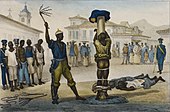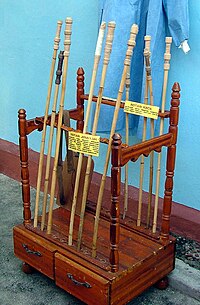
A corporal punishment or a physical punishment is a punishment which is intended to cause physical pain to a person. When it is inflicted on minors, especially in home and school settings, its methods may include spanking or paddling. When it is inflicted on adults, it may be inflicted on prisoners and slaves, and can involve methods such as whipping with a belt or a horsewhip.

Rattan, also spelled ratan, is the name for roughly 600 species of Old World climbing palms belonging to subfamily Calamoideae. The greatest diversity of rattan palm species and genera are in the closed-canopy old-growth tropical forests of Southeast Asia, though they can also be found in other parts of tropical Asia and Africa. Most rattan palms are ecologically considered lianas due to their climbing habits, unlike other palm species. A few species also have tree-like or shrub-like habits.

Caning is a form of corporal punishment consisting of a number of hits with a single cane usually made of rattan, generally applied to the offender's bare or clothed buttocks or hands. Caning on the knuckles or shoulders is much less common. Caning can also be applied to the soles of the feet. The size and flexibility of the cane and the mode of application, as well as the number of the strokes, may vary.

Birching is a form of corporal punishment with a birch rod, typically applied to the recipient's bare buttocks, although occasionally to the back and/or shoulders.
In 1994, a court in Singapore sentenced an American teenager, Michael Fay, to be lashed six times with a cane for violating the Vandalism Act. This caused a temporary strain in relations between Singapore and the United States.
Saint Andrew's Secondary School is a government-aided Anglican all-boys' secondary school in Potong Pasir, Singapore. Established in the 19th century, it still operates along traditional British lines and offers a four- or five-year programme, leading to the Singapore-Cambridge GCE Ordinary Level or Singapore-Cambridge GCE Normal Level examinations.

The Pudu Prison, also known as Pudu Jail, was a prison in Kuala Lumpur, Malaysia. Built in phases by the British colonial government between 1891 and 1895, it stood on Jalan Shaw. The construction began with its 394-metre prison wall at a cost of 16,000 Straits dollars, and had been adorned with the world's longest mural at one point in its history. The cells were small and dark, each only the size of a shoebox.

The tawse, sometimes formerly spelled taws is an implement used for corporal punishment. It was used for educational discipline, primarily in Scotland, but also in schools in a few English cities e.g. Newcastle upon Tyne, Gateshead, Liverpool, Manchester and Walsall.

Caning is a widely used form of corporal punishment in Singapore. It can be divided into several contexts: judicial, prison, reformatory, military, school and domestic. These practices of caning as punishment were introduced during the period of British colonial rule in Singapore. Similar forms of corporal punishment are also used in some other former British colonies, including two of Singapore's neighbouring countries, Malaysia and Brunei.
Tay Yong Kwang is a Singaporean judge of the Supreme Court. He was first appointed Judicial Commissioner in 1997, appointed Judge in 2003, and appointed Judge of Appeal in 2016. He was noted for being the presiding judge in several notable cases that shocked the nation and made headlines in Singapore.

Corporal punishment is banned in the penal and education systems of the Republic of China (Taiwan), but there are no laws banning its use in the home. However, as of 22 March 2023, there is a draft amendment of Article 1085 of the Civil Law that may make some forms of corporal punishment in the home illegal if it comes into effect.

School corporal punishment is the deliberate infliction of physical pain as a response to undesired behavior by students. The term corporal punishment derives from the Latin word for the "body", corpus. In schools it may involve striking the student on the buttocks or on the palms of their hands with an implement such as a rattan cane, wooden paddle, slipper, leather strap or wooden yardstick. Less commonly, it could also include spanking or smacking the student with an open hand, especially at the kindergarten, primary school, or other more junior levels.

Judicial corporal punishment is the infliction of corporal punishment as a result of a sentence imposed on an offender by a court of law, including flagellation, forced amputations, caning, bastinado, birching, or strapping. Legal corporal punishment is forbidden in most countries, but it still is a form of legal punishment practiced according to the legislations of Brunei, Iran, Libya, the Maldives, Malaysia, Saudi Arabia, Singapore, the United Arab Emirates, Yemen, and Qatar, as well as parts of Indonesia and Nigeria.

The Arms Offences Act 1973 is a statute of the Parliament of Singapore that criminalizes the illegal possession of arms and ammunition and the carrying, trafficking, and usage of arms. The law is designed specifically to make acts of ownership, knowingly receiving payment in connection with the trade of a trafficked armaments and ammunition, as well as the unlawful usage of arms and ammunition a criminal offence.

Beer in Malaysia started in 1968, when two leading breweries of Guinness and Malayan Breweries merged to form a new company known as Guinness Anchor Berhad. Previously, the distribution of beer in Malaysia is mainly distributed by Malayan Breweries Limited which is centred in neighbouring Singapore. Carlsberg establish its first brewery outside Kuala Lumpur in 1970. By 2007, one local brewery began to establish their presence in the country although the demands for commercial beers are much higher than a new local brand. Most beers in the Malaysian markets are imported from neighbouring countries such as Singapore, Thailand, Indonesia, Philippines and Vietnam. In 2022, finally Malaysia had its very own craft beer brand known as PaperKite. PaperKite is also the first Malaysian craft beer brand to win the World Beer Awards in 2023.

Caning is used as a form of judicial corporal punishment in Brunei. This practice is heavily influenced by Brunei's history as a British protectorate from 1888 to 1984. Similar forms of corporal punishment are also used in two of Brunei's neighbouring countries, Singapore and Malaysia, which are themselves former British colonies.

Yap Weng Wah, alias Wai Loon or Loon, is a Malaysian serial sex offender, who formerly worked as a quality assurance engineer, and is currently jailed in Singapore for 76 sexual offences committed against 31 teenage boys aged between 11 and 15 in Singapore. He befriended his victims online, had sex with them and filmed his illegal acts. During police investigations, Yap was found to have raped 14 more boys in Malaysia in between his constant trips from Singapore to Malaysia before his arrest.

Life imprisonment is a legal penalty in Singapore. This sentence is applicable for more than forty offences under Singapore law, such as culpable homicide not amounting to murder, attempted murder, kidnapping by ransom, criminal breach of trust by a public servant, voluntarily causing grievous hurt with dangerous weapons, and trafficking of firearms, in addition to caning or a fine for certain offences that warrant life imprisonment.

Bala Kuppusamy, a Singaporean citizen, was a convicted robber and serial rapist who had committed various offences of rape, robbery and molestation from 1985 to 2008. His first offence of raping and robbing a 19-year-old woman in 1985 led to him being sentenced to 11 years' jail and 28 strokes of the cane, and his second conviction for sexually assaulting two students and four robberies led to him sentenced to 23 years' jail and 24 strokes of the cane.













